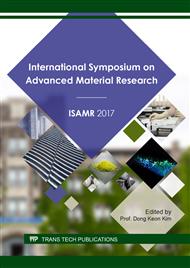p.156
p.163
p.168
p.173
p.183
p.188
p.194
p.200
p.206
Modelling of Surface Roughness in Ultra-High Precision Turning of an RGP Contact Lens Polymer
Abstract:
Contact lens manufacture requires high accuracy and surface integrity. Surface roughness an important response because it has direct influence toward the part performance and the production cost. Hence, choosing optimal cutting parameters will not only improve the quality measure but also the productivity. This research work is therefore aimed at developing a predictive surface roughness model and investigate a finish cutting conditions of ONSI-56 contact lens polymer with a monocrystalline diamond cutting tool. In this work, a novel surface roughness prediction model, in which the feed rate, cutting speed and depth of cut are considered is developed. This combined process was successfully modeled using a Box–Behnken design (BBD) with response surface methodology (RSM). The effects of feed rate, cutting speed and depth of cut were investigated. Analysis of variance (ANOVA) showed that the proposed quadratic model effectively interpreted the experimental data with coefficients of determination of R2 = 0.89 and adjusted R2 = 0.84. The worse surface value was obtained at high feedrate and low spindle speed.
Info:
Periodical:
Pages:
183-187
Citation:
Online since:
August 2017
Price:
Сopyright:
© 2017 Trans Tech Publications Ltd. All Rights Reserved
Share:
Citation:


